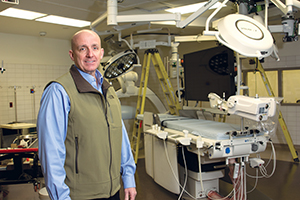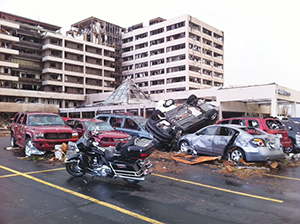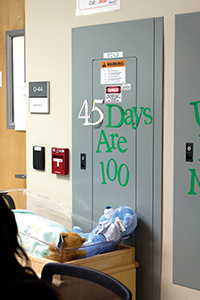By BETSY TAYLOR
JOPLIN, Mo. — Mercy Hospital Joplin will open a permanent replacement hospital here on March 22, almost four years after a massive tornado cut a deadly swath through this southwest Missouri city, resulting in 161 deaths and the destruction of the former Mercy hospital, St. John's Regional Medical Center.

Mercy's Executive Director of Strategic Projects John Farnen shows the features of a hybrid operating room during a preview tour of the new Mercy Hospital Joplin. The operating room allows for high level imaging, minimally invasive procedures and open surgical procedures. (Photo credit: Hal Robertson)
Joplin is still rebuilding. A typical residential street in the storm zone shows renewal and signs of lingering destruction. New homes and houses under construction stand alongside cleared lots. The few mature trees that survived the storm appear wind ravaged and gnarled. Despite reposted street signs, parts of the city can be difficult to navigate due to some new roads and addresses.
"Every day it's a struggle. Even today, it's a struggle," said Tammy Comer, 52, from her family room in a new home. The soil in her yard was being replaced during a recent visit, part of a lead remediation project in a neighborhood where homes crumpled and blew to pieces in the storm. She lives just blocks from where the former hospital used to stand. Comer was born at St. John's in Joplin and said the hospital reopening will mark a milestone for the city. "With Mercy getting ready to reopen, that's a little bit of light at the end of the tunnel," she said.
Direct hit
Though many times communities lose residents following a natural disaster, the population of Joplin has remained stable at roughly 50,000 residents. Many in the community credit Mercy's commitment to Joplin as a constant reassurance in a time of uncertainty.

The tornado that tore through Joplin, Mo., on May 22, 2011, claimed 161 lives including six at St. John’s Regional Medical Center. The hospital, seen in the background, took a direct hit and was later demolished. Today, an open air chapel stands on the site of the former hospital. (Courtesy of Mercy)
The multiple-vortex tornado, at least a half mile wide with winds estimated at 200 miles an hour, powered its way from Joplin's western edge to the eastern city limits and continued on to rural Jasper and Newton counties. The hospital took a direct hit from the tornado, windows exploded and parts of the roof peeled away. Nurses and technicians threw their bodies over patients to shield them from flying glass shards and lit evacuation routes with the flashlight features on their cell phones after the power failed. The tornado ripped away an emergency generator. The hospital looked like it had been hit by a bomb. Staff and first responders scrambled around in the chaotic wreckage to evacuate patients to safety. Five patients, who had been in critical condition, and one visitor at St. John's Regional Medical Center died.
In the midst of widespread devastation, Mercy had patient services up and running within hours of the storm. At first, clinicians provided emergency first aid and triage in Joplin community buildings, next the staff moved to hospital tents and then to a temporary hospital, made up of 224 modular units welded together and finished on site. The temporary, modular building is located just east of the site of St. John's Regional Medical Center.

Staff at the temporary hospital are counting down the days until the new Mercy Hospital Joplin opens on March 22. (Photo credit: Hal Robertson)
The new, $465 million Mercy Hospital Joplin is located close to Interstate 44, about 3 miles away from the previous hospital site. Mercy Hospital Joplin serves patients from four states — Missouri, Kansas, Arkansas and Oklahoma — and the site is easily accessible by highway and centrally located for the Joplin community.
Learning from hard experience
Having experienced the terror-inducing, full force of an EF5 tornado, Mercy saw the practical and emotional value in building a storm-hardened replacement hospital. The new hospital has a precast concrete shell; windows with glass designed to withstand winds of 250 miles per hour and impact from speeding objects and that flex to accommodate sudden rapid changes in air pressure as happens during a tornado.
"We could have done a number of things to harden the building, but we did the things that we thought would have the most impact and that co-workers who had lived through the storm in the other building would appreciate," said Lynn Britton, president and chief executive of the Joplin facility's parent, Mercy of Chesterfield, Mo. Utility buildings are storm hardened as well, with two lines for power, water and data communications entering the hospital from different directions so damage from one direction would not shut down all service. Ventilators and neonatal intensive care unit bassinets will have up to two hours of back-up battery power. Emergency supplies like shovels and crowbars have been positioned throughout the hospital. During the emergency response to the tornado, staff had a hard time accessing first aid kits and flashlights stored in central locations.
Easy access
The new 900,000-square-foot hospital will open with 200 beds in private rooms, with shell space for up to 260 total beds. It was designed to be easy to navigate for patients, their visitors and staff. Cynthia Beckham, Mercy's executive director for facility design, said when she works on a hospital design, she thinks of her parents, who are in their 80s.

A main entrance design at Mercy Hospital Joplin incorporates a large cross to reflect the hospital’s Catholic identity. The hospital’s windows, one of many storm-hardening features, can flex to withstand high winds and sudden changes in air pressure. (Photo credit: Hal Robertson)
"How do we make it as easy as possible for them to get to where they're going?" Parking surrounds Mercy Hospital Joplin, so patients don't have to walk far. There are landscaped pathways from the parking lots and canopies at entrances to shelter patients dropped off at a door.
Mercy Hospital Joplin has two main entrances: one for the hospital side of the building and one for the clinic side. The upper floors have been designed so specialists can work efficiently. For instance, an obstetrician gynecologist could see scheduled patients in his or her office on the clinic side of the hospital, then walk down the hall to deliver a baby in the obstetrics unit.
Beckham and John Farnen, who is Mercy's executive director of strategic projects, point out small touches in the private rooms. Patients can stow a rollable suitcase in a lockable storage space in their rooms. Couches fold down into beds to accommodate a family member spending the night. About 30 rooms have ceiling tracks to allow for lifts that assist with moving heavy patients.
The new hospital has a Level III neonatal intensive care unit, the first Mercy NICU in Joplin. The hospital also will return to its Level II trauma status and restart its radiation oncology service, two aspects of care that were not maintainable in the temporary hospitals.
From the ground up
The ground floor of the hospital includes the emergency department, inpatient diagnostic imaging, hybrid operating rooms and a laboratory. The hospital has 50 "prep hold" rooms, where patients and their families can wait in private before an outpatient procedure, with restrooms situated between rooms so gowned patients won't have to trek down the hall. The post-acute care unit, which is a recovery area, includes open bays separated by curtains, so clinicians can monitor patients coming out of anesthesia before the patients are brought back to their prep hold room.

The Stations of the Cross from the storm-ravaged hospital adorn the new chapel at Mercy Hospital Joplin. (Photo credit: Hal Robertson)
It will be easier for staff to access medical equipment throughout the hospital as wheelchairs, IV pumps and other items carry radio-frequency and infrared identification tags which allow a computer program to pinpoint their location. A communications system will send patient alarms directly to nurses' cell phones.
"Many of the products used (in) this facility are used in many health care facilities," Beckham said. "What we did here that is truly transforming health care is how we put it all together from the perspective of patients and staff."
Beckham said design elements call on Mercy's history and heritage. Stations of the Cross and other Catholic symbols and statuary salvaged from the tornado-ravaged hospital are incorporated into the new hospital. Quotes that honor the hospital's Catholic mission and the legacy of Mercy's founders adorn windows, fountains and benches. Beckham said, "We want to bring the caring spirit of the Sisters of Mercy into everything we do."
| Mercy staff looks forward to opening of new hospital JOPLIN, Mo. — In a Mercy administrative office here, an electronic counter ticks down the days, hours and minutes until the new hospital opens on March 22. Outside the maternity wing of the temporary Mercy Hospital Joplin, a handmade sign tracks the days remaining "Until Babies are Born at 100 Mercy Way," the address of the permanent replacement hospital. Anticipation is mounting almost four years after the routine of the Mercy staff's daily work lives was shattered by a killer tornado on May 22, 2011. Jeanette Dunlap, a mammography technologist, recalled how a beautiful Sunday morning gave way to a powerful storm that day. She lost power at her Diamond, Mo., home about 25 miles from the hospital in Joplin, but was prepared to go into work Monday morning. Then she learned that Mercy's Joplin hospital had been destroyed. She feared she and her Mercy co-workers would lose their jobs, but within 48 hours she received an email from Mercy President and Chief Executive Lynn Britton telling Mercy staff in Joplin that everyone was still employed. "That was a relief," she said. Mercy's Executive Vice President and Chief Operating Officer Michael McCurry was leaving a church service in the St. Louis area where Mercy is headquartered, about 275 miles away, when he heard the first of a string of calls about extensive tornado damage in Joplin and at the Joplin hospital. He began coordinating the company's response with Mercy leaders on the ground in Joplin and in suburban St. Louis. Around 7 a.m. the morning after the tornado, Britton asked Mercy's legal and marketing departments to research disaster recovery efforts in communities and determine what factors contributed to success and which to long-term disruption. The research showed that communities suffered when skilled residents permanently resettled elsewhere in pursuit of jobs or housing. It was hard to rebuild a workforce. Mercy leadership made it a priority to retain its Joplin-area staff, so that Mercy could continue its health care mission there. Mercy committed to providing "continuation pay" for the 2,200 people it employed prior to the tornado. Mercy established a "talent share" program which allowed employees to review available jobs online and apply for positions. Some associates took temporary jobs with Mercy in other states. The system kept the retention program running through the fall of 2014, when Mercy determined it was no longer needed. Last month, Mercy Hospital Joplin had about 1,500 employees on its payroll, and it expected to have about 1,800 employees, including new hires, when fully staffed in March, said Gary Pulsipher, the hospital's president and chief executive. Dunlap said that in the months following the storm she rotated through a series of work assignments, some far afield from her technical training. She did clinical support work and even took a night shift cleaning doctors' offices in the fall of 2011. "Even though it was hard, and the work was difficult, it was satisfying," she said. At times, there wasn't work for her, and she teared up as she said she didn't feel right about receiving pay when she wasn't working, despite the circumstances. She managed a mobile mammography van, based at the small Mercy Hospital Columbus in Columbus, Kan., for about two years, commuting about 45 minutes from her home, before being assigned to the temporary Mercy Breast Center Joplin located in a Joplin office building. She said reporting to the breast center at the new Mercy Hospital Joplin will feel "like everyone is coming home again." Theresa Ukena, a senior accountant for Mercy, said in the disorienting aftermath of the tornado she took comfort in Mercy's commitment to remain in Joplin and to keep staff employed. For eight months, she made a three-hour daily round-trip commute between her home in Carthage, Mo., and temporary Mercy offices set up in Fort Scott, Kan. "I was so thankful to have a job. It was just one of the things you did," she said. Ukena currently works much closer to home at a Mercy accounting office in a Joplin strip mall. Co-workers posted "street" signs to help workers navigate through the rows of identical office cubicles there. The Irish street names are a nod to the country where Catherine McAuley founded the Sisters of Mercy, Mercy's founding congregation, in 1831. Ukena said some of her Mercy colleagues found the changes to new or temporary positions, to different shifts or office locations too difficult logistically for them or their families. But even among some who left Mercy, there is a feeling of loyalty because Mercy worked to keep them employed. She said among those employees, there's a feeling that: "Mercy stuck by me, so I'm going to stick by them," she said. |
| Mercy Hospital Joplin commits to telehealth Mercy, the parent of Mercy Hospital Joplin, says its telemedicine programs allow it to provide more care to patients where and when it's needed. The temporary hospital that Mercy built in Joplin already participates in several of Mercy's telemedicine programs, with more telehealth planned at the new hospital. Such telehealth programs allow patients at Mercy Hospital Joplin to be monitored remotely to reduce complications and to have an electronic consultation when a specialist is not immediately available at the same location. Mercy is building a virtual care center in Chesterfield, Mo., the suburban St. Louis community where Mercy is based. Scheduled to open in mid-2015, the system says the center will accommodate nearly 300 physicians, nurses, specialists, researchers and support staff. Care will be delivered around the clock through audio, video and data connections to locations across Mercy's four-state system, including Mercy Hospital Joplin, as well as outside of Mercy through partnerships with other health care providers and large employers, according to the system. A Mercy spokesperson said Mercy Hospital Joplin's telehealth offerings at the new hospital will include: Tele-ICU Mercy's oldest telemedicine program already monitors about 500 beds in 15 hospitals across five states. More than 40 board-certified critical care physicians and 60 critical care nurses help monitor remote patients, reducing complications such as ventilator-associated pneumonia and central blood line infections while also reducing length of stay and mortality. Telesepsis — This technology helps monitor distant patients at risk for bacterial infections that can lead to life-threatening, whole-body inflammation called sepsis. Mercy says in a statement that telesepsis helped reduce by half deaths from severe infections at Mercy Hospital St. Louis and shortened the average stay in intensive care by more than two days. Telestroke — Patients rushed to an emergency room anywhere in a network of nearly 30 hospitals are able to receive rapid, specialized care from distant neurologists. Time is crucial as medication proves most effective within 90 to 180 minutes after stroke symptoms first appear. eAcute — The newest of Mercy's telemedicine services, eAcute extends the type of monitoring that is typical of intensive care beds to general medical and surgical floors. Nurses are able to sit at a workstation and monitor data generated by distant patients. Ten Joplin beds are being wired with eAcute sensors and video links that will help reduce patient complications and discomfort, and their associated costs. |
Copyright © 2015 by the Catholic Health Association
of the United States
For reprint permission, contact Betty Crosby or call (314) 253-3477.